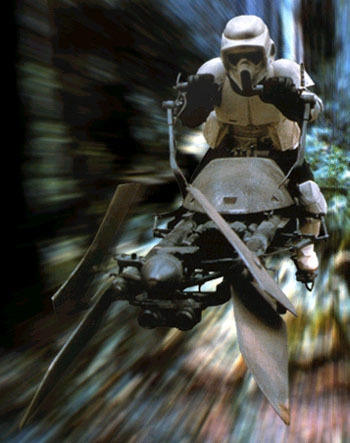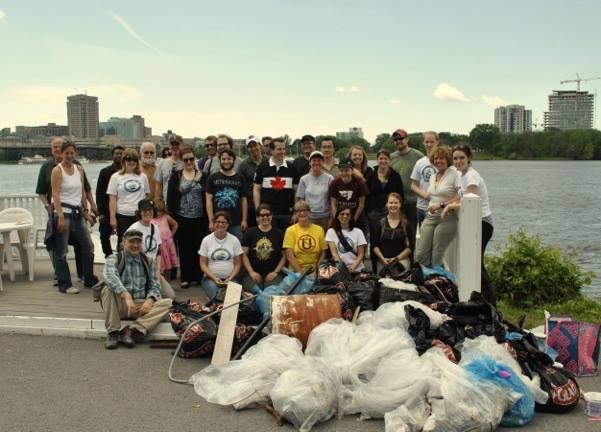
Putting the “Science” in “Science Fiction” – Hover Vehicles
Hover vehicles have shown up in many works of science fiction and taken many forms, including the hover tanks of the Battlezone series, Halo’s motorcycle like Ghost, and the well known Snowspeeders from Star Wars. Although they are portrayed as being used in different roles and being built with different technologies the thing that all these machines have in common is their ability to effortlessly hover above the ground. Hover vehicles have many advantages over conventional wheeled or tracked ones, as they are completely all terrain and thus have a much higher maximum speed and greater maneuverability than their earth-bound cousins. Unfortunately such craft are also very difficult to make, and there are no current means available to mimic the silent and perfectly controlled hovering of these fictional craft. In most science fiction works the science behind hover vehicles is rarely fully explained, usually with passing references to anti-gravity such as with Star Wars’ repulsorlift engines. Despite the difficulty in creating machines that hover above the ground scientists are working to make such a thing possible, and there are several potential ways to go about achieving a similar effect.

The oldest and most successful attempts to create hovering vehicles resulted in the creation of the aptly named hovercraft. These vehicles operate by using a number of fans to create an area of high pressure air underneath the vehicle. The air is trapped beneath the vehicle through the use of a skirt made of a flexible material like rubber or fabric, creating a cushion of air that allows the hovercraft to move across the ground and even over water with little difficulty. In order to provide lift hovercraft use large propellers or fans to push them around, handling more like aircraft or ships than ground vehicles. Although a hovercraft may sound like a light and flimsy vehicle this is far from the truth, with hovercraft being able to carry heavy loads for long distances. The ultimate example of this is the Russian Navy’s Zubr class hovercraft, which is capable of carrying three main battle tanks or ten armoured vehicles and one hundred and forty soldiers. This carrying capacity comes without sacrificing speed or armament, and it is for this reason that hovercraft see use in many militaries. Hovercraft’s ability to move over water and land while carrying heavy loads makes them perfect for military landings on beaches or moving troops and equipment around quickly and efficiently. Although they have many advantages hovercraft are also very noisy and are more vulnerable to attack than conventional ground or sea vehicles, and can only operate on fairly level terrain. Although these problems do limit the military use of hovercraft it does not prevent these versatile vehicles from seeing use in civilian applications as well, and civilian hovercraft range in size from small one person pleasure craft to massive ferries that can carry dozens of cars and hundreds of passengers. The versatility of hovercraft allow them to be used where other vehicles would have difficulty, like in thick mud, swamps, everglades, and shallow water, and so they are often used as coast guard and search and rescue vehicles. Although they have many uses and a promising future, hovercraft cannot operate over all terrains and do not float as high as the hovering vehicles of science fiction.

Another form of real-world hover vehicles are maglev, or magnetic levitation, trains. These trains use electromagnets to create a magnetic field between the train and track, allowing it to float above its tracks. These magnetic fields are also used to move the train forwards and backwards, similar to a railgun, and allow them to move at very high speeds while causing little strain on their tracks. The low strain on the tracks means that they are less likely to fail due to damage, and so the chance of derailment is smaller. Maglev trains are also quieter and more energy efficient than their wheeled counterparts, and the cost of creating a maglev system are already equal or less than the cost of building a high speed train system. These costs are expected to drop even more once maglev trains become more common. The system used in maglev trains could also be extended to other vehicles, such as city trams, but this technology has several inherent difficulties that limit its usefulness in many situations. The largest problem with electromagnetic levitation is that it requires a track, which immediately limits its usefulness to dedicated routes. Although maglev systems are very useful as a replacement for trains and monorails they cannot act as a replacement for other more flexible vehicles due to this restriction. Another problem is that certain types of maglev trains cannot levitate properly at low speeds, and require a secondary wheel system to move them until they hit a speed where they begin to hover. It is also costly to replace an existing train system with maglev technology, as the trains are not compatible with standard tracks and so the entire rail system must be replaced with new rails for the maglev trains to use. Despite these limitations magnetic levitation has a promising future as a replacement for conventional trains, and as new discoveries are made it may become possible to use this technology without requiring a rail system.

Another possible technology for the creation of hover vehicles, and by far the most promising, are the ducted fans being used by the Aerofex company. These devices consist of a circular shroud or duct built around a small propeller. This arrangement helps the propeller to be more efficient at lower speeds and produces less noise and damage to the environment than larger propellers, like those used on helicopters. Aerofex is continuing the research undertaken by the U.S. Military in the 1960’s that created the Airgeep, exploring the possibility of creating a small hover vehicle through the use of ducted fans. Their design, which is currently in the prototype stage, is not much larger than a conventional motorcycle and claims to have simple and intuitive handling. If it functions similarly to its Airgeep predecessor this vehicle will be able to operate at ground level or high in the sky with no reduction in performance, and its use of small engines will hopefully give it high fuel efficiency and low cost. Although it is still in the prototype stage and it may be a long time until a finished model is ready to roll off the assembly lines Aerofex’s vehicle seems to promise the best hope for a future filled with hover vehicles. If the technology used in this bike-like craft is shown to be safe, effective, and economically feasible it will likely be expanded to include other types of vehicles in the future. This vehicle is a considerable achievement in itself as well, and if it goes into mass production its small size and ease of use will allow it to be used in many applications, from military patrols to civilian search and rescue.
While many technologies have promise when it comes to creating a future of hovering vehicles we are still far away from the hovering sky-platforms and zipping speeder bikes of Star Wars. Although it may be possible to create such things someday for now the technology simply doesn’t exist in the modern world. This is partially because of limitations of modern technology, but a large part of the problem lies with the way hover vehicles are portrayed in science fiction. By describing hover vehicles as operating by manipulating gravity, a fundamental force we cannot yet fully understand nonetheless control, science fiction creators go far beyond what is currently possible. Although the creation of some of the fantastic devices in science fiction may never be possible it will always give us something to strive towards, and that is one of science fiction’s greatest gifts to us.








